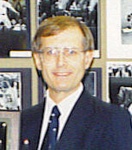Henry Chadwick Award: Tom Heitz
This article was written by Steve Gietschier
This article was published in Fall 2012 Baseball Research Journal
 TOM HEITZ (b. 1940), lawyer, librarian, town ball enthusiast, and friend to hundreds of baseball researchers, ran the library at the Baseball Hall of Fame from 1983 to 1995. During that time, he oversaw a construction project that transformed an old-fashioned library into a modern research institution. “Up to that point,” he told Rafael Alvarez of the Baltimore Sun in 1994, “it was a private hunting preserve for scholars and the privileged. The standard was that you had to be a serious researcher to get into our files, but who can tell that by looking at someone?” Heitz’s changes opened the library to everyone. “We don’t care how serious or whimsical you are, whether you’re doing your dissertation or looking up Uncle Charlie’s batting average when he was in the Piedmont League,” he said. For this revolution, SABR members will be forever grateful.
TOM HEITZ (b. 1940), lawyer, librarian, town ball enthusiast, and friend to hundreds of baseball researchers, ran the library at the Baseball Hall of Fame from 1983 to 1995. During that time, he oversaw a construction project that transformed an old-fashioned library into a modern research institution. “Up to that point,” he told Rafael Alvarez of the Baltimore Sun in 1994, “it was a private hunting preserve for scholars and the privileged. The standard was that you had to be a serious researcher to get into our files, but who can tell that by looking at someone?” Heitz’s changes opened the library to everyone. “We don’t care how serious or whimsical you are, whether you’re doing your dissertation or looking up Uncle Charlie’s batting average when he was in the Piedmont League,” he said. For this revolution, SABR members will be forever grateful.
Heitz was born in Kansas City. He played baseball as a child, but also tried to master the violin. “I had to practice my scales for three to four hours before I could play baseball, and my violin instructor was in some anxiety over my baseball career,” he recalled. “He didn’t have to worry. I was too near-sighted to be a hitter.”
Heitz gave some thought to becoming a law professor like his father, but his goals changed when he joined the Marines in 1966. After his discharge, he attended library school at the University of Washington and worked as an assistant law librarian at the University of Puget Sound. He applied for the job at Cooperstown while working as a law librarian for the attorney general of the state of New York. Officials at the Hall of Fame “appreciated the fact that I was a fan, but you don’t have to love your subject to do a good job,” he said.
Heitz did love his subject, of course, and he quickly became recognized as an expert on baseball, its history, and its rules. While the contributions of librarians and archivists to scholarship often remain behind the scenes, such people occasionally let their scholarly lights shine, as Heitz did in compiling the monumental rules chronology, “Rules and Scoring,” first published in the first edition of Total Baseball. (Later editions also acknowledge Dennis Bingham.)
Moreover, he promoted playing town ball, thereby at least indirectly encouraging the growth of the vintage baseball movement. Heitz helped organize the Leatherstocking Club that played town ball every weekend at Cooperstown’s Farmers’ Museum for more than a decade, and for many years he organized the town ball game at the Cooperstown Symposium on Baseball and American Culture. This conference, which he co-founded as baseball’s first annual academic symposium, will celebrate its 25th anniversary in 2013.
The library’s expansion, completed in 1993 at a cost of six million dollars, increased the facility’s square footage from 7,000 to 29,000. It provided archival storage for the collection, adding temperature and humidity control, proper lighting, and enhanced security. The construction also created an interior connection between the library and the museum, a boon to visitors and scholars. The new Bullpen Theater became a space for movies, talks, book signings, and other events. Heitz hired additional professional librarians, and he began a preservation program to care for the Hall’s documents. Under his leadership, the library expanded the scope of its collection beyond what earlier generations had envisioned.
Simultaneously, Heitz was a member of the North American Sports Library Network (NASLIN) and SABR. With Bob Davids and Steve Gietschier, he sat on the inaugural committee to decide the Macmillan-SABR Baseball Research Awards from 1987 to 1995, at which time he helped reconstruct the research awards program, redefining the Macmillan Award and creating the Seymour Medal and the Sporting News-SABR Baseball Research Award.
For more information on the Henry Chadwick Award, click here.


